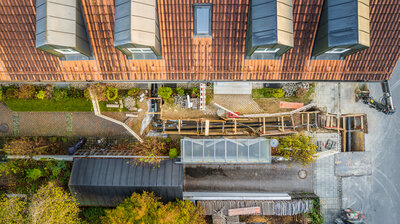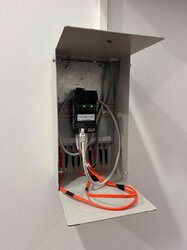
Smart network for district heating in Unterhaching

Heat from the depths
When the first geological surveys were carried out in Unterhaching at the end of the last millennium, there were many skeptics. Today, the project is considered groundbreaking: sulphurous thermal water with a temperature of 122 degrees Celsius is pumped up from a depth of over 3,500 meters. Heat exchangers are used to heat the water in the district heating network to up to 110 degrees Celsius. While the thermal water is fed back into the same water-bearing rock layer (aquifer) three kilometers away, where it heats up again, the water in the district heating network flows through the municipality. In each connected household, the water of the internal building heating circuit is heated - again via a heat exchanger. Thanks to the high output temperature of the geothermal source, the existing buildings in the municipality, some of which are historic, can also be heated effortlessly.
Foresight in many areas
With the founding of Geothermie Unterhaching GmbH & Co KG in 2002, the municipality of Unterhaching laid the foundation for an innovative heat supply. Today, the use of geothermal energy already saves more than 30,000 tons of CO2 per year. Efficient control of the district heating network is crucial for its smooth operation. In this respect too, those responsible have shown foresight. They made the decision to lay fiber optics in parallel with the expansion of the district heating network in order to be able to control and monitor the technology. An intelligent technical solution was to be implemented within the buildings, switching from fiber optics to copper. On recommendation, MICROSENS was approached as a German manufacturer and expert in the field. Several thousand Micro Switches will be installed in the Unterhaching district heating network over the next few years.

Management via a central system
Niklas Gercke (Head of Technology, Geothermie Unterhaching) explains. "The reliability of the switches really impressed us. The only thing we were missing was the option to access them centrally via a management system." The increasing complexity of the network and the reform of the 2021 Heating Cost Ordinance, which makes the installation of remotely readable meter systems mandatory, required this functionality. In order to meet the increasing requirements, a central network management system had to be implemented and the switches replaced accordingly. With the Ruggedized Micro Switch, MICROSENS was also able to win this tender economically and technically. The new generation of compact switches can be recorded and controlled via the manufacturer's central network management system. The control and regulation technology of the district heating network also runs via the switches, which are connected directly to the standard household 230V power supply. There is no need for additional transformers and all electricians can carry out the installation.
Changeover in stages
Since the end of 2021, all new district heating connections in Unterhaching have been equipped with the ruggedized micro switch from MICROSENS. Existing customers will receive a new switch in exchange by 2026. Rising gas prices and supply bottlenecks, as well as the local council's decision that Unterhaching should be climate-neutral by 2030, have further increased interest in geothermal energy. The expansion of the district heating network is currently in full swing, as Niklas Gercke explains: "This is where the major advantages of MICROSENS technology become apparent. We can access each switch directly via the NMP software and read out network data, such as the attenuation on the fibers or the general network topology, as well as control technology parameters directly. Remote maintenance and troubleshooting are much easier." Especially with the ring-shaped topology of the network in Unterhaching, it is important to detect and rectify failures quickly so as not to interrupt the data flow. On the customer side, the components are connected to the switch via an RJ45 connection and communication takes place via TCP/IP. This means that the heat consumption of the connected households can also be read out via the switches to the exact date. The central server, on which the NMP software runs, is also integrated into the network via a ruggedized switch.

Technology with a future
Overall, deep geothermal energy in Unterhaching is futureproof in several respects: according to forecasts, the heat source will probably only become slightly cooler over the next 80 years. The geothermal plant therefore guarantees a stable supply for the connected households for decades to come. The association with a neighboring geothermal operator offers a backup option in the event of maintenance work and disruptions in the network. Due to the high flow temperature of the district heating network, older existing buildings can also be heated without expensive conversion measures. In order to give all households the opportunity to benefit from these advantages, the full expansion of the municipal district heating network in Unterhaching was unanimously approved by the local council and is due to be completed by 2028. By then, the dedicated fibre optic network with the ruggedized switches in Unterhaching will also have to be expanded in parallel with the district heating network. The pre-configured components supplied by MICROSENS simplify installation in this smart metering concept and impress with their reliable function.
About MICROSENS
Transmitting information via fiber optic connections offers numerous benefits. MICROSENS GmbH & Co. KG recognised this very early on. As one of the pioneers, the company has developed and produced high-performance communications and transmission systems in Germany since 1993. Individually matched to the demands of diverse usage areas and embedded in comprehensive concepts for individual sectors. But, above all, close to the customer. Technical challenges from customer projects are incorporated directly into product development. This way, IP-based automation solutions are created for modern buildings, cost-efficient network concepts for the office and workspace, robust and fail-safe solutions for industrial environments, optical transport systems future-oriented wide area networks and efficient coupling of sites and computer centres.











